|
|
Updated as per The Known Sphingidae of Costa Rica, November 2007
Updated as per More, Kitching and Cocucci's Hawkmoths of Argentina 2005, December 2009
Updated as per
AN ANNOTATED CHECKLIST OF THE SPHINGIDAE OF BOLIVIA, December 2009
Updated as per personal communication with Gregory Nielsen (Villavicencio, Meta, Colombia, April 6, 2011, 500m); April 21, 2011
Updated as per CATE Sphingidae (additions: Honduras, Venezuela, Ecuador, Peru, Paraguay, Brazil); May 13, 2011
Updated as per French Guiana Systematics: Sphingidae; May 13, 2011
Updated as per James P. Tuttle's The Hawk Moths of North America, 2007; September 24, 2011
Updated as per personal communication with Gregory Nielsen (Villavicencio, Meta, Colombia, September 19, 2011, 500m); September 24, 2011
Updated as per personal communication with Ben Trott (Playa del Carmen, Quintana Roo, Mexico); April 21, 2012
Updated as per personal communication with Thomas Jantscher (Lee County, Iowa, October 16, 2012); December 19, 2012
Updated as per "A Hawk Moths fauna of southern Maranhão state, Brazil, ... "; NEVA: Jahrgang 34 Heft 3 November 2013; via Jean Haxaire; April 5, 2014
Updated as per personal communication with Sergio D. Ríos Díaz in CATÁLOGO DE LOS SPHINGIDAE (INSECTA: LEPIDOPTERA) DEPOSITADOS EN
EL MUSEO NACIONAL DE HISTORIA NATURAL DEL PARAGUAY; sent to me in July 2014 by Sergio D. Ríos Díaz.
Updated as per personal communication with Ezequiel Bustos (Shilap revta. lepid. 43 (172) diciembre, 2015, 615-631 eISSN 2340-4078 ISSN 0300-5267), January 4, 2016
Updated as per personal communication with Francierlem Oliveira (Extremoz, Rio Grande do Norte, Brazil, May 21, 2016); May 28, 2016
|
Erinnyis obscura
(Fabricius, 1775)
Obscure Sphinx Moth
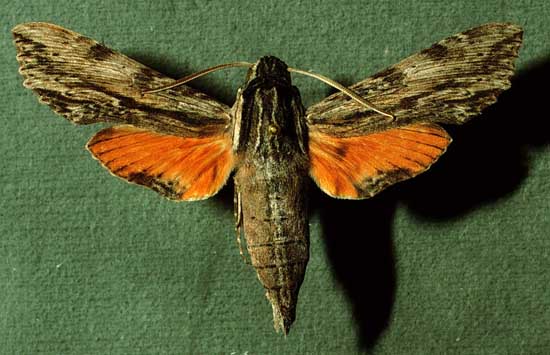
Erinnyis obscura male courtesy of Dan Janzen.
This site has been created by
Bill Oehlke at oehlkew@islandtelecom.com
Comments, suggestions and/or additional information are welcomed by Bill.
TAXONOMY:
Family: Sphingidae, Latreille, 1802
Subfamily: Macroglossinae, Harris, 1839
Tribe: Dilophonotini, Burmeister, 1878
Genus: Erinnyis Hubner, [1819] ...........
Species: obscura Fabricius 1775
|
MIDI MUSIC
.....It's a Wonderful World.....
copyright C. Odenkirk
ON.OFF
<bgsound src="world.mid" LOOP=FOREVER>
|
DISTRIBUTION:
The Obscure sphinx, Erinnyis obscura
(Wing span: 2 3/16 - 2 9/16 inches (approximations: males: 56-59mm; females: 59-65mm)),
flies in tropical and subtropical lowlands
from
Uruguay;
Brazil: Maranhao; Rio Grande do Norte (FO); and
Paraguay: Amambay, Central, Canindeyu, Presidente Hayes, Alto Paraguay; west to
Bolivia: La Paz, Cochabamba, Santa Cruz; and
Argentina: Buenos Aires, Catamarca, Cordoba, Corrientes, Chaco, Entre Rios, Formosa, Jujuy, La Rioja, Misiones, Salta, Sante fe,
Santiago del Estero, Tucuman;
and north through
Peru;
Ecuador;
Colombia: Meta;
Venezuela;
French Guiana: Matoury, Sinnamary;
through Central America; to Honduras: San Pedro Sula;
Mexico; and the West Indies to Florida, Mississippi, Texas, New Mexico,
Arizona, and southern California. This species has also strayed to Arkansas, Oklahoma, Nebraska, North Dakota, Iowa (TJ) and
Pennsylvania.
I suspect it also flies in Guyana and Suriname.
In many classifications (CATE) those moths formerly determined as Erinnyis domingonis are synonymized with obscura, but French Guiana Systematics
still (2011) recognizes domingonis as distinct. I do not know (2011) the status of domingonis after barcoding analysis.
James P. Tuttle reports in his book The Hawk Moths of North America, 2007, that he has reared larvae from eggs of a single female of
Erinnyis obscura that have resulted in two different larval colour morphs. The emergent moths from this rearing showed two different adult morphs, a light
form and a dark form. He also reports there was no consistency between the larval morphs and the adult forms that resulted from them.
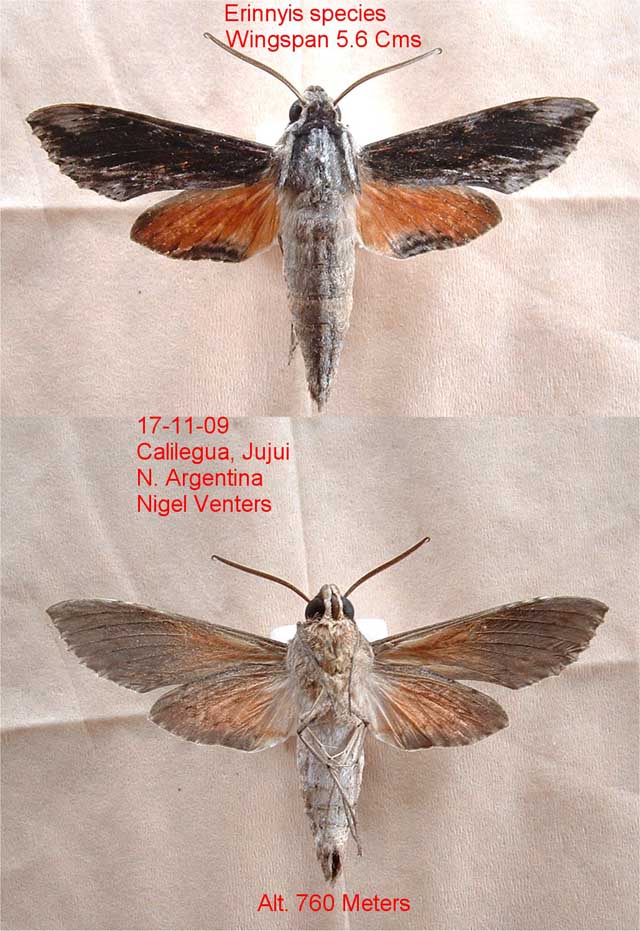
Erinnyis obscura, 56mm, dark form, Calilegua, Jujuy, Argentina,
November 17, 2009, 750m, courtesy of Nigel Venters.
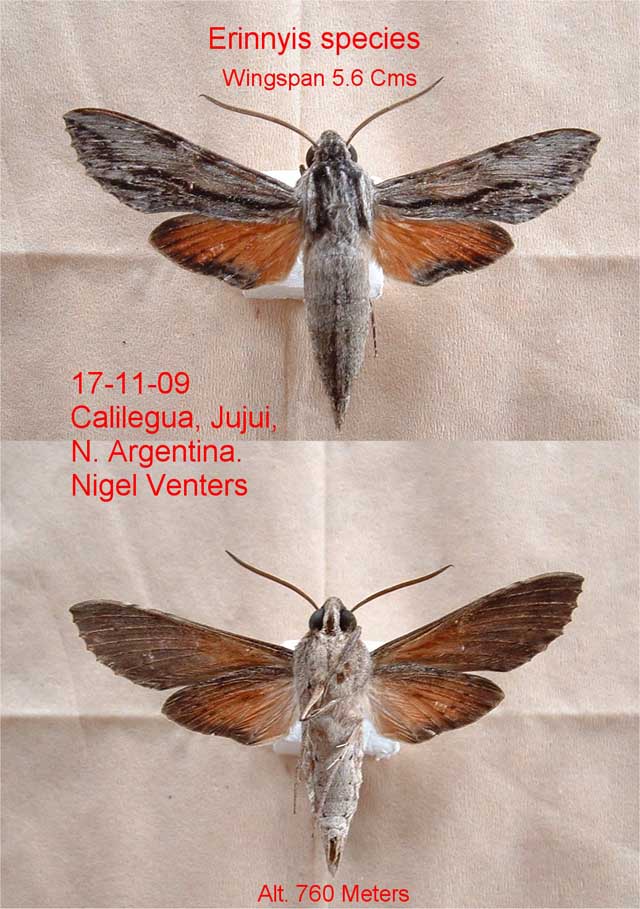
Erinnyis obscura, 56mm, light form, Calilegua, Jujuy, Argentina,
November 17, 2009, 750m, courtesy of Nigel Venters.
The female moth has almost uniformly grey forewings with black markings on the basal half and near the
center of the costa like Erinnyis ello; some females are nearly all black. The upperside of the male forewing is
pale gray with black markings and a black line in the center running from the base to about three-fourths of the wing
length. In both sexes, the hindwing upperside is orange with a narrow black border.
Visit Erinnyis obscura, Extremoz, Rio Grande do Norte, Brazil,
May 21, 2016, courtesy of Francierlem Oliveira.
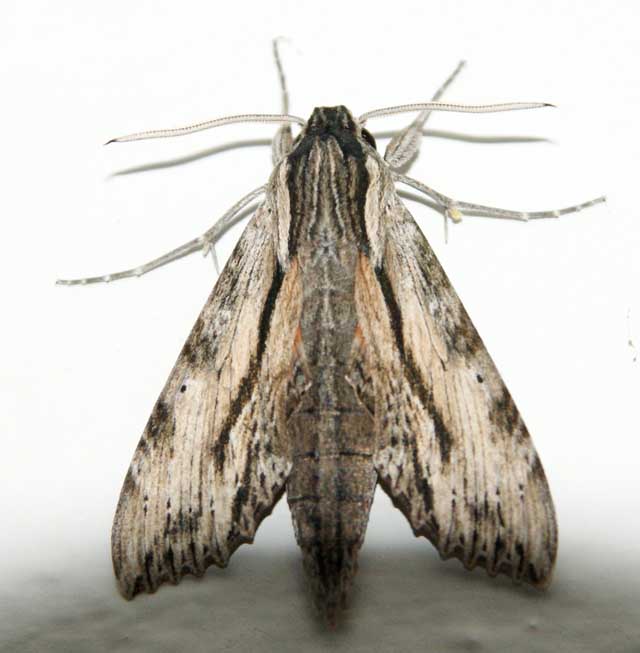
Erinnyis obscura male, Islamorada, Monroe County, Florida,
November 19, 2008, courtesy of Kevin and Shelby Heeter.
FLIGHT TIMES:
Erinnyis obscura broods continuously in the tropics and in southern Florida and
southern Texas. Specimens have been taken in French Guiana in March and November, and probably in other months.
January, March, June, August-September, October, December.
During the night adults nectar at flowers, including bouncing bet (Saponaria officinalis)
and Asystasia gangetica beginning at dusk.
Moths are on the
wing from July-August in the southern United States. Further northward there is a single flight from August-October.
In Costa Rica moths have been taken in all months except
March and September.
Lynda McGinnis reports a very early sighting in
Missouri, April 28, near Lake of the Ozarks by Jack Richerson.
Gregory Nielsen reports an April 6, 2011, as well as a September 19, 2011, flight in Villavicencio, Meta, Colombia.
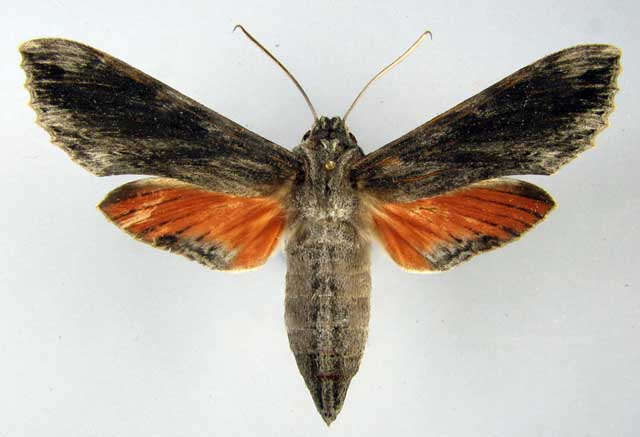
Erinnyis obscura female, Villavicencio, Meta, Colombia,
Km 13 via Acacias
04°03’55.0 N 073°41’87.0 W; FWL = 31 mm
Wingspan 62 mm;
April 6, 2011, 500m, courtesy/leg. Gregory Nielsen.
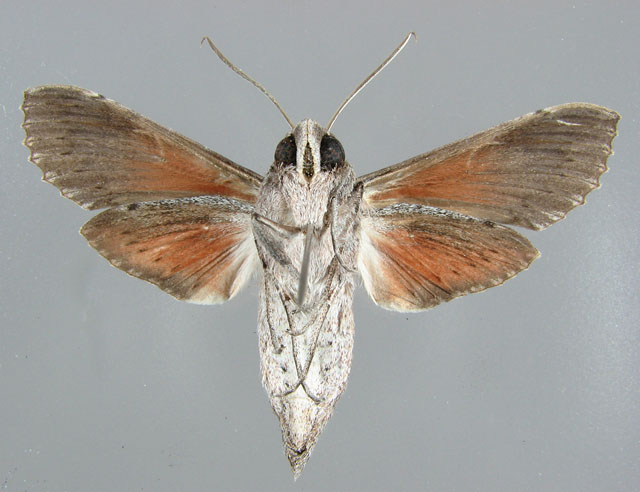
Erinnyis obscura female (verso), Villavicencio, Meta, Colombia,
Km 13 via Acacias
04°03’55.0 N 073°41’87.0 W; FWL = 31 mm
Wingspan 62 mm;
April 6, 2011, 500m, courtesy/leg. Gregory Nielsen.
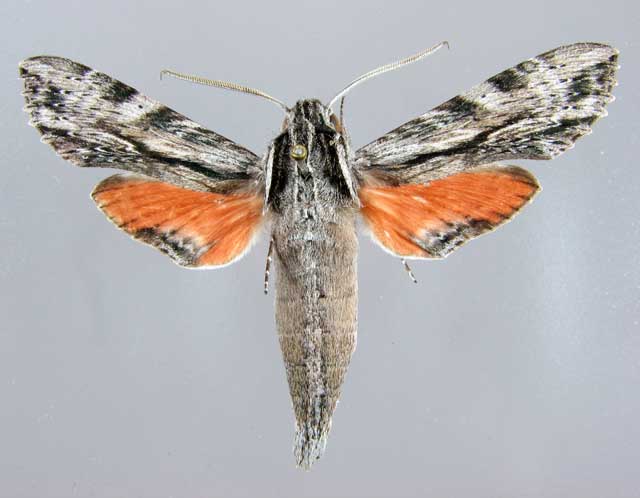
Erinnyis obscura male, Villavicencio, Meta, Colombia,
Km 13 via Acacias
04°03’55.0 N 073°41’87.0 W; FWL = 28mm;
September 19, 2011, 500m, courtesy/leg. Gregory Nielsen.
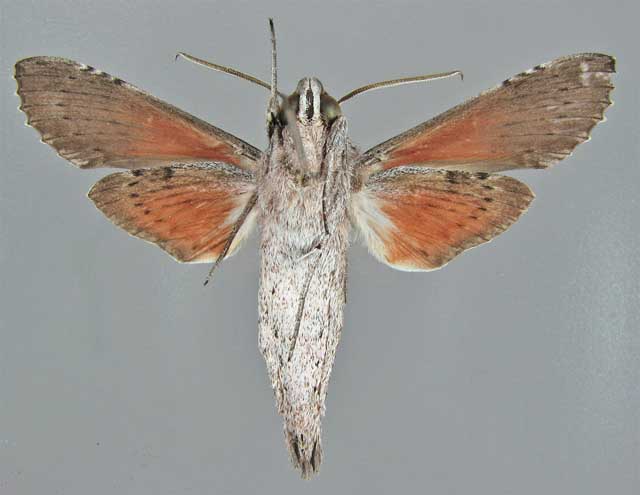
Erinnyis obscura male (verso), Villavicencio, Meta, Colombia,
Km 13 via Acacias
04°03’55.0 N 073°41’87.0 W; FWL = 28mm;
September 19, 2011, 500m, courtesy/leg. Gregory Nielsen.
ECLOSION:Adults eclose from pupae formed in loose cocoons spun among surface litter.
Pupal stage can be as few as fourteen days.
SCENTING AND MATING:Females call in the males with a pheromone released from a gland at the tip of
the abdomen. Adults begin feeding at sunset. 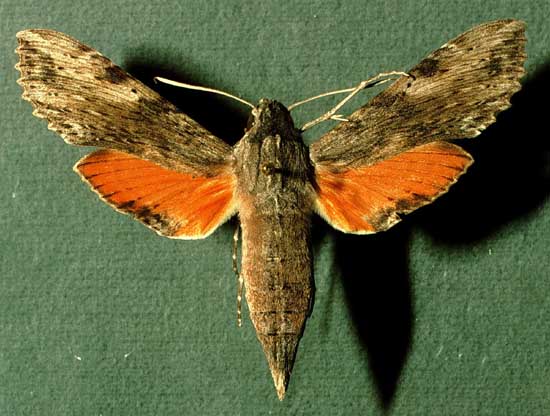 Erinnyis obscura female courtesy of Dan Janzen.
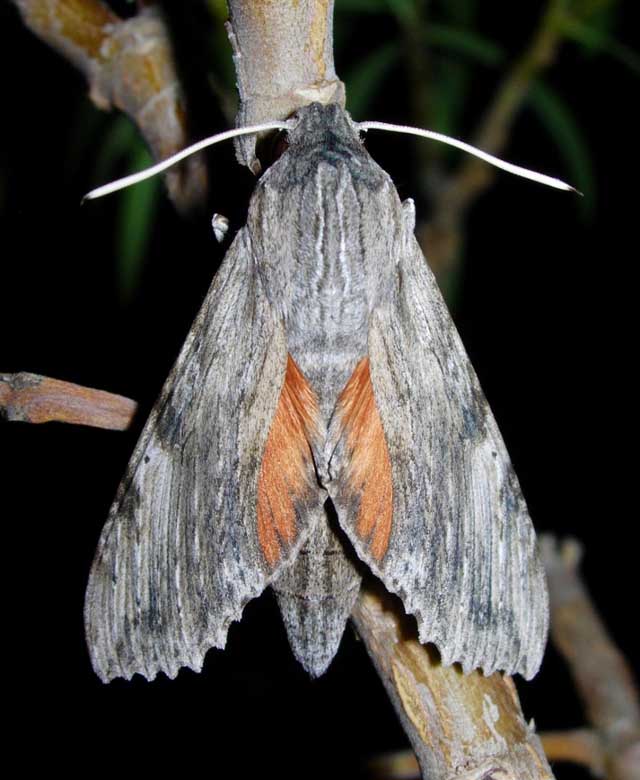
Erinnyis obscura female, Playa del Carmen, Quintana Roo, Mexico,
March 1, 2012, courtesy of Ben Trott.
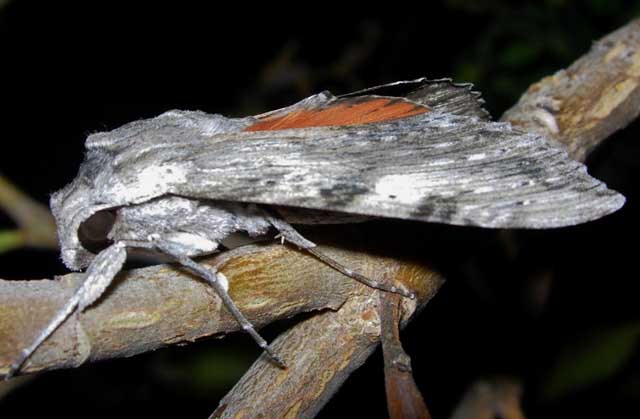
Erinnyis obscura female, Playa del Carmen, Quintana Roo, Mexico,
March 1, 2012, courtesy of Ben Trott.
EGGS, LARVAE, PUPAE:Larvae probably feed on various plants in the dogbane family (Apocynaceae):
Rauvolfia ligustrina, Rauvolfia tetraphylla, Stemmadenia obovata, Philibertia, Cynanchum, and on
papaya (Carica papaya, Caricaceae), and Asclepiadaceae. Some plants in the spurge family are
also used and Blepharodon mucronatum is a host in Costa Rica. In Florida larvae have
been found on white vine (Sarcostemma
clausum) and on Morrenia odorata.
Erinnyis obscura larvae have no eyespot on the dorsum.
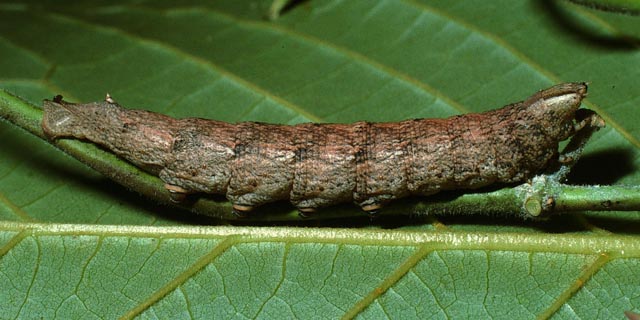
Erinnyis obscura, Costa Rica, courtesy of Dan Janzen.
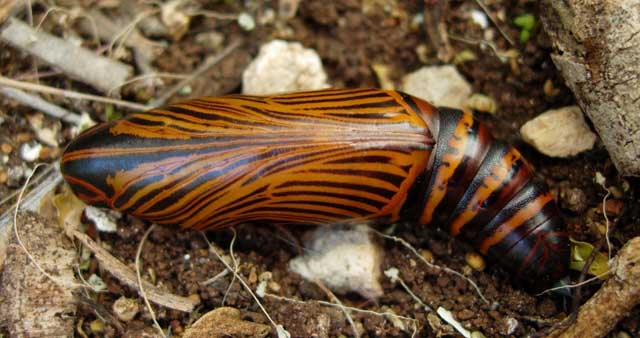
Erinnyis obscura female pupa, Playa del Carmen, Quintana Roo, Mexico,
courtesy of Ben Trott.
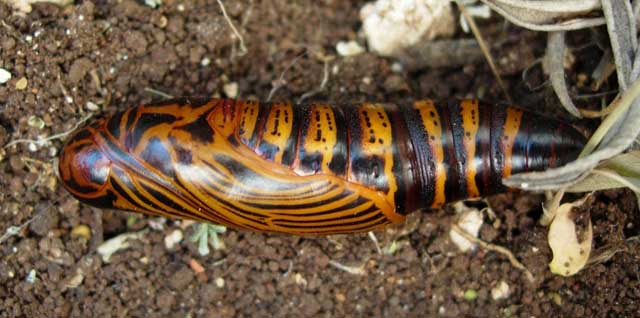
Erinnyis obscura female pupa, Playa del Carmen, Quintana Roo, Mexico,
courtesy of Ben Trott.
Return to U. S. A. Table
Return to Sphingidae Index
Return to Dilophonotini Tribe
|













